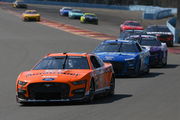
via Imago
Image Credits: Imago

via Imago
Image Credits: Imago
Just recently, Formula One just wrapped up its second visit to the United States of America. This comes after the F1 race at Miami earlier this year, and the long-standing race at Circuit of The Americas. Now later down the line, Las Vegas is expected to make its debut on the F1 calendar. With Liberty Media at the helm, they are keen for F1 to become a strong presence in the United States. As a result, they are pushing for more American races. However, F1 will have to face stern competition from the likes of NASCAR and IndyCar.
To be frank, F1 operates on a more global basis, while NASCAR is focused on the United States. Both sports have been giants in their own fields and have been around for almost the same amount of time. Admittedly, NASCAR is just about 2 years older than Formula One. Bence, both are regarded as the biggest in their field. Interestingly, IndyCar is a lot older than F1 and NASCAR but is not as popular as the other two.
ADVERTISEMENT
Article continues below this ad
What did the numbers look like in F1 and NASCAR?
Recently, one of the biggest complaints about NASCAR is its dipping viewership numbers. Previously, when it came to the American audience, the viewership gulf between NASCAR and F1 was massive. The numbers heavily favored the former, but over the years, F1 has been closing the gap. In 2022, the inaugural F1 Miami Grand Prix coincided with the NASCAR Cup race at Darlington. According to the Harvard Crimson, both recorded an average of 2.6 million viewers in America.

via Reuters
Formula One F1 – Japanese Grand Prix – Suzuka Circuit, Suzuka, Japan – September 24, 2023 Red Bull’s Max Verstappen celebrates on the podium with a trophy after winning the Japanese Grand Prix alongside second placed McLaren’s Lando Norris and third placed McLaren’s Oscar Piastri REUTERS/Androniki Christodoulou
One of the key differences, apart from physical ones, is the perception of both sports. NASCAR prides itself as a sport with tough cars, tough drivers, and racing that is rough and tumble. Formula One, on the other hand, prides itself on elegance and being known as the pinnacle of motorsport. However, this kind of reputation also means that F1 is extremely expensive, as teams push the boundaries to go faster. Sure, there have been attempts to limit this by allocating budgets, but that doesn’t take away the fact that Formula One is expensive.
READ MORE: This is Why NASCAR Drivers Have Longer Careers Compared to Formula 1 Drivers
Trending
What is F1 doing right, that its American counterpart isn’t?
Ever since Liberty Media took over the reins in 2018, they have been trying to broaden F1’s appeal. Safe to say, their attempts have been a roaring success, as viewership grew rapidly in the United States. Reports even say that the average viewership between 2018 and 2022 skyrocketed to 1.4 million from 500,000. A large part of it is thanks to the rise of social media, younger drivers drawing in new fans, and more.

USA Today via Reuters
Sep 16, 2023; Bristol, Tennessee, USA; NASCAR Cup Series driver William Byron (24) and driver Martin Truex Jr. (19) and driver Alex Bowman (48) during the Bass Pro Shops Night Race at Bristol Motor Speedway. Mandatory Credit: Randy Sartin-USA TODAY Sports
Finally, F1 drew its trump card, the Netflix docuseries ‘Drive to Survive’, and that was a godsend. The show was so popular that its fourth season was the most-watched Netflix show in 33 countries, including the USA. As per the New York Times, more than one-third of attendees at the 2022 US Grand Prix in Austin came because of the series. But the question is, has Formula One overtaken NASCAR as the fastest-growing motorsport in America?
What can NASCAR do to compete with F1?
Admittedly, NASCAR viewership has been on a downward spiral since 2005. What is concerning is that F1’s recent meteoric rise could mean that the answer for NASCAR, to beat F1, is a change in leadership. Unfortunately, the situation with NASCAR is such that any attempt to broaden viewership not only tanks but also faces stern resistance. If NASCAR can try and appeal to a younger American audience, it could go a long way.
Of course, one way that NASCAR could have the upper hand is with ticket prices. Since F1 is an expensive sport, ticket prices were always going to be exorbitant. In fact, the upcoming Las Vegas Grand Prix has an average ticket price of $1,667 US dollars. Meanwhile, the average ticket price for a NASCAR race typically ranges between $30 and $120 US dollars. In other words, as long as NASCAR can keep its on-track attendance prices at a reasonable level, they could have more appeal than F1.
However, they do have to do something about TV coverage, because the grandstands can only fit so many people. With the TV numbers going down for NASCAR, there is cause for alarm. Of course, there have been attempts like the introduction of the Playoff format, new tracks, more road courses, and even re-visiting old tracks. The latter has been met with widespread acclaim, especially with the return of the North Wilkesboro Speedway.
ADVERTISEMENT
Article continues below this ad
How else does NASCAR have an edge over its counterpart?
It is worth mentioning that it is very difficult to dominate in NASCAR on a statistical level. Sure, NASCAR has three 7-time Cup Series champions, but they battled hard. The only driver who actually ‘dominated’ was Richard Petty, with an astounding 200 Cup Series wins. In 1967, Petty triumphed in 27 out of 48 races, and obviously won the championship that year. Other than that, it is hard for one driver to truly dominate.
So while Max Verstappen is rattling off race wins, with barely any competition, NASCAR is more unpredictable. In fact, the last time a NASCAR champion won back-to-back titles was Jimmie Johnson from 2006 until 2010. Meanwhile, Verstappen is on a hot streak from 2021 all the way until 2023, and before him was Lewis Hamilton from 2017 until 2020. To be frank, this kind of domination can make things monotonous for many fans, maybe except for the winning driver’s fans.
In 2022, Formula One witnessed five different winners across the span of a 22-race season. On the other side of the Atlantic, the 2022 NASCAR Cup Series season saw a record-equaling 19 different race winners. The last time such a phenomenon occurred was during the 1956, 1958, 1961, and 2001 seasons. 2022 was actually the first time it happened during the Playoff format era, and it made the sport unpredictable. 2023 has not been so lucky, but it still had a fair number of surprises. Among them is defending champion Joey Logano who was eliminated in the opening Playoff round.
ADVERTISEMENT
Article continues below this ad
Having looked at the facts and the statistics, it seems if NASCAR doesn’t take any major steps toward course correction, then they should very well be threatened by F1’s presence, or rather NASCAR fans switching to F1, at the very least.
WATCH THIS STORY: After a Failed Attempt to Mirror the $179,830,000,000 Giant’s Success Formula, NASCAR’s Latest Playoff Update Has the Racing Community Going Bonkers
ADVERTISEMENT
ADVERTISEMENT
ADVERTISEMENT
ADVERTISEMENT





